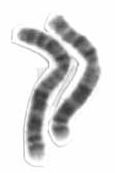
A practical qPCR approach to detect TERRA, the elusive telomeric repeat-containing RNA.
Sign Up to like & getrecommendations! Published in 2017 at "Methods"
DOI: 10.1016/j.ymeth.2016.08.004
Abstract: Telomeres, the heterochromatic structures that protect the ends of the chromosomes, are transcribed into a class of long non-coding RNAs, telomeric repeat-containing RNAs (TERRA), whose transcriptional regulation and functions are not well understood. The identification… read more here.
Keywords: chromosome ends; repeat containing; practical qpcr; telomeric repeat ... See more keywords

Telomere-to-telomere assembled and centromere annotated genomes of the two main subspecies of the button mushroom Agaricus bisporus reveal especially polymorphic chromosome ends
Sign Up to like & getrecommendations! Published in 2020 at "Scientific Reports"
DOI: 10.1038/s41598-020-71043-5
Abstract: Agaricus bisporus, the most cultivated edible mushroom worldwide, is represented mainly by the subspecies var. bisporus and var. burnettii. var. bisporus has a secondarily homothallic life cycle with recombination restricted to chromosome ends, while var.… read more here.
Keywords: chromosome ends; annotated genomes; bisporus; var bisporus ... See more keywords

The makings of TERRA R-loops at chromosome ends
Sign Up to like & getrecommendations! Published in 2021 at "Cell Cycle"
DOI: 10.1080/15384101.2021.1962638
Abstract: ABSTRACT Telomeres protect chromosome ends from nucleolytic degradation, uncontrolled recombination by DNA repair enzymes and checkpoint signaling, and they provide mechanisms for their maintenance by semiconservative DNA replication, telomerase and homologous recombination. The telomeric long… read more here.
Keywords: dna; chromosome ends; makings terra; recombination ... See more keywords

Long-read assembly and comparative evidence-based reanalysis of Cryptosporidium genome sequences reveals expanded transporter repertoire and duplication of entire chromosome ends including subtelomeric regions.
Sign Up to like & getrecommendations! Published in 2021 at "Genome research"
DOI: 10.1101/gr.275325.121
Abstract: Cryptosporidiosis is a leading cause of waterborne diarrheal disease globally and an important contributor to mortality in infants and the immunosuppressed. Despite its importance, the Cryptosporidium community has only had access to a good, but… read more here.
Keywords: long read; chromosome ends; annotation; cryptosporidium ... See more keywords

Telomere Roles in Fungal Genome Evolution and Adaptation
Sign Up to like & getrecommendations! Published in 2021 at "Frontiers in Genetics"
DOI: 10.3389/fgene.2021.676751
Abstract: Telomeres form the ends of linear chromosomes and usually comprise protein complexes that bind to simple repeated sequence motifs that are added to the 3′ ends of DNA by the telomerase reverse transcriptase (TERT). One… read more here.
Keywords: interstitial telomere; chromosome ends; telomere maintenance; telomere roles ... See more keywords

R-Loops at Chromosome Ends: From Formation, Regulation, and Cellular Consequence
Sign Up to like & getrecommendations! Published in 2023 at "Cancers"
DOI: 10.3390/cancers15072178
Abstract: Simple Summary R-loops, also referred to as RNA: DNA hybrids, are tripartite structures formed when a single-stranded RNA molecule forms a complex with a double-stranded DNA duplex via homology-directed base pairing. Many cellular functions are… read more here.
Keywords: dna; chromosome ends; regulation; loops chromosome ... See more keywords